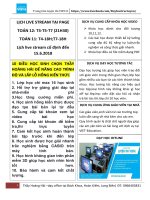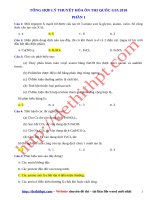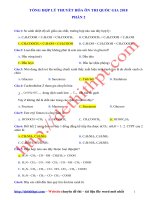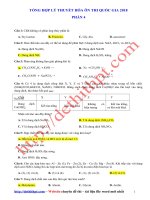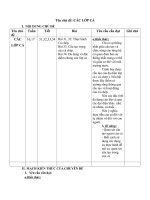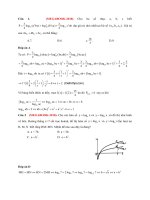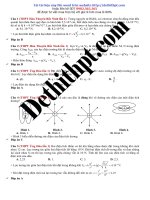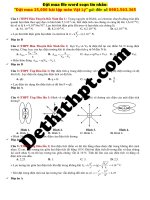Cs224W 2018 75
Bạn đang xem bản rút gọn của tài liệu. Xem và tải ngay bản đầy đủ của tài liệu tại đây (5.44 MB, 7 trang )
Developer Collaboration Prediction on Github
Songlin Qing[ging0001],
I.
Yiling Chen[yilingc],
GitHub,
and
predict
if
two
authors
will
collaborate in the next quarter. Data from each
quarter will be mapped to a weighted authorproject bipartite graph. Then we will thoroughly
compute similarity metrics on two different
weighted homogeneous developer graphs folded
from the weighted bipartite graph. Lastly, we
will build a supervised classification model and
incorporate developer features both inside and
outside network topology. Feature importance of
different similarity metrics will be compared and
analyzed.
II.
RELATED
[1] formalized the link pre-
diction problem and evaluated different approaches
to predict link formation by measuring the proximity of nodes in several un-weighted homogeneous co-authorship networks
Gouap. Though
the
methods performed much better than a random
predictor, the overall accuracy was not high. When
narrowing down the nodes to be analyzed, they
picked nodes that appeared in both training and
test sets with more
agreed that G.oliap iS a lossy representation of the
bipartite network as much information are lost in
the projection process.
To preserve the collaboration strength information, Newman (2001) [2] proposed an edge weight
assignment formula that considers the collaboration project size and collaboration times. Zhu and
Xia (2016)
than 3 degrees,
which biased
[3] carried out empirical experiments
on 4 weighted homogeneous networks and showed
that the weighted scores outperformed the traditional un-weighted indices.
Grover
and
Leskovec(2016)[11]
proposed
a
node representation learning algorithm, node2vec,
and showed that the node embedding can be used
to predict missing link with better performance
than using local similarity and spectral clustering.
Gao
et al (2018)[12]
improves
the random
walk
approach for bipartite networks to encode implicit
relations.
Sa and Prudencio
(2011)
[5] combined
super-
vised learning and weighted graphs and achieved
a satisfactory result. However, they only incorporated the metrics computed from the network
structure,
network.
WORK
Link prediction has been a focused research area
in recent years, given its wide application in academic, governmental and commercial uses. Liben
and Kleinberg (2007)
[sqyang]
the estimation of prediction accuracy. The authors
INTRODUCTION
As the world’s most popular community of open
source software development, Github has millions
of enthusiastic developers collaborting, forking and
creating new projects every day. Because of the
unique way Github is designed, it allows easy
collaboration for users to work on the same project
at the same time. It will be extremely useful if
Github can suggest potential collaborators to users
with similar software development background.
In this project, we would like to analyze
the commit activities from authors to projects
and interactions within the author community
on
Shigi Yang
III.
A.
DATA
not
information
SET AND
available
GRAPH
outside
the
REPRESENTATION
Dataset
We propose to use the GHTorrent[6] dataset,
which is an archive of the Github public events
queried through the Github REST API as far back
as 2007. The dataset contains granular information
of Github users, organizations, repositories, programming languages, commits, pull requests and
issues.
As
of Oct
2018,
the
GHTorrent
dataset
includes 46.7M repositories and 16.2M users. In
our project, we queried GHTorrent via Google
BigQuery.
With the goal of predicting developer collaboration,
we
retrieve
all commits
repositories that are:
1) tagged with the Python
guage;
2)
in the
i
itory Graph
- sec distrbution. G(598844, 1081257). Largest component has 0.355750 nodes
THY
GitHub
programming
lan-
have two or more commit authors in the first
quarter of 2016.
In the resulting data set, there are 326,996 repos-
itories, 271,848 commit authors’, and 1.08M
repository author combination that has non zero
commit count. We
also retrieve the commits
with
the same criteria for the second quarter of 2016 as
our validation set.
(a) Size distribution of strongly connected components
Max SCC Degree Distribution. G(598844, 1081257). 97700 (0.1631) nodes with in-deg
> avg deg (3.6), 47938 (0.0801)
with >2'avg.deg
B. Graph Representation
1) Developer-Repository Graph: We can define
a developer-repository bipartite graph based on
the commit dataset where there are two modes
of nodes - developers and repositories, where a
developer and a project is linked when the developer has authored one or more commits in
the project. The link can be optionally weighted
by the number of commits by the author in the
project over the given period of time. The resulting
bipartite graph has 599K nodes and 1.08M edges,
with one giant component covering 213K nodes
and 796K edges. The approximate diameter of the
giant component with 100 sample is 29. Some
network characteristics are shown in Fig 1.
2) Developer Collaboration Graph: The twomode developer-repository graph can be projected to a one-mode developer collaboration graph
where two developers are connected when they
have authored commits to one or more repositories.
For the weighted graph, there are different ways to
project the weights:
1) Newman (2001)[2] proposed an edge weight
assignment
formula that considers
the
collaboration project size and collaboration
times.
oko
=2 ——
n1
wi;= >
3
(1)1
‘Note that we use commit author, the person who initially wrote
the code, instead of the committer, the person who performs the
commit, to better capture the collaboration. When the author differs
from the committer, it is usually due to that the author does not
have commit right to the repository.
(b) Degree distribution of the giant component
Fig. 1: Network characteristics of the developerrepository graph
Where
nz represents the number of authors
who committed to the repository, 5 is 1 if
author i committed to project k and 0 if not.
Each collaboration is normalized with the
total authors and combining collaborations
together gives us the strength of collaborations between author i and author j.
With the Newman
score, authors who
have
committed to the same repository have an
edge in the one-mode projection. However,
this score does not take into account how
many commits have the author performed
thus two users who committed to a project
once each still shows connected.
2) We also propose an alternative weight assignment for the projected edge, Common
remaining in the graph. This pruning process result
in 4.6M possible collaborating node pairs, and
narrow down our analysis scope to highly active
developers (more than 25 projects) and medium to
large sized projects (more than 25 authors).
Remaining Author Node after
Deleting Nodes Degree <: =k
Author Count Vs. K-Core
IV.
0
10
20
30
40
50
k-Core
60
70
Fig. 2: K-Core Decomposition
APPROACH
In this section, we implement several metrics of
similarity on weighted author graph folded from
the author-repository bipartite graph. We analyze
local/global features and community features to
obtain the similarity between each node pair.
Let I(x) be the set of neighbors of node x, and
w(x,y) be the edge weight between node x and
node y. Because our graph is undirected weighted
Commit
graph, w(x,y) = w(y, x).
Index(CCT):
CCly
=
log(Š ` min(c?,
c*))
Where c* is the commit count for developer
c in project k. Here we consider the collaboration between two developers to be the
lesser number of commits between the two in
each project summing over all projects they
collaborate in.
C. Scope Narrow-down
As covered in section B, the largest Strongly
Connected Component in the bipartite graph contains 213K nodes including 89.9K authors. There
are 4B possible collaborating node pairs, which
makes even the simplest local similarity scores
calculation a non-trivial task. Liben and Kleinberg
filtered out authors
Local Similarities
e Common
k
(2007)[1]
A.
who
published less
than 3 papers in both training and test periods in
the Goilap analysis. We think this practice is flawed
as the test data is leaked into training set and
the resulting graph is not necessarily connected.
Instead, we implemented k-core decomposition [7]
to prune the author and project nodes on the
bipartite graph to narrow down the number of
author node pairs to a manageable size, while
keeping the MxSCC connected.
As author and project node share similar degree
distribution, we pruned author and project degrees
at the same rate. As shown in Fig2, after removing authors with 25 or less projects and projects
with 25 or less authors there are 3053 authors
Neighbor
3
(CN):
mt
w(z, z)
+
wy; z)
(2)
The most basic approach is to count the
number
of common
neighbors
between
author x and author y. A fair amount of
common neighbors indicates the two authors
are likely to collaborate in the future. In
the weighted graph, we also took the edge
weights between their common neighbors
and themselves into account.
e Jaccard’s
Coefficient (JC):
w(x, z) + wly, Z)
daeelreerrre)
Ð2aer(z)(4,
x) = 3 2»er(u)tUẲ, 1)
(3)
The Jaccard’s coefficient values the similarity
between pair of nodes with low degrees more
than pair of nodes with high degrees. In our
case, if two authors both are highly dedicated
authors who commit more than 1000 projects
within a quarter, their similarity score will
be downsized by the number of collaborators
on their own.
e Adamic-Adar
Coefficient (AA):
w(x,z) + AZ’
w(y, Zz)
7
decir ey re)
log(1
+ Veer(zW(C, z))
(4
“
The Adamic-Adar coefficient is a derivate
of the JC coefficient. It assigns a higher
similarity score to common neighbors with
low
degrees
(Sa,
&
two authors both
dedicated authors
collaborators,
Prudencio
,2011).
If
collaborate to a highly
with a large group of
their
similarity
score
will
be
lower than neighbors with a small group of
collaborators.
e Preferential Attachment
Ề 2c)
w(a,
+)
+
to
a new
node.
cry) tu(b, 1)
In
our
case,
the
two
Katz
The
Katz
[8]
sums
over
the
paths
|
Define the weighted adjacency matrix (W):
W = {wj;;],wij = w(i,j), the weighted degree
matrix (D): D = [dj], dit = 337—¡ ¿j. According
to Shi and Malik (2000)[9], the normalized spectral
clustering works with eigenvalues and eigenvectors
paths
Lạ=D
(5)
author might collaborate in the future if they
both have large weights with their existing
collaborators.
B.
D. Normalized Spectral Clustering
of the normalized Laplacian matrix (L,,):
(PA):
Because the degree distribution of the user
graph follows the power-law distribution, we
also included Preferential Attachment as one
of our proximity metrics. PA assumes that
nodes with high degrees are more likely to
link
a binary operator. The node pair representation
can then be leverage for link prediction.
!1L—=TI— D'1W
(7)
The reason we choose normalized instead of unnormalized spectral clustering is that the normalized one obtain clusters by achieving two objectives: minimize the between-cluster similarity
and maximize the within-cluster similarity, while
the unnormalized one only implements the first
objective.
Then we select the number of clusters by finding
the rank k that maximizes eigengap A; : A; =
|À¿ — À,¬].
between
two nodes with different lengths and penalize the
longer paths exponentially by the value of Ø(0 <
1).
S`/Ø!.
=1
(6)
The matrix of Katz scores can be calculated by
(I — BA)~' — I, where A
eigenvalues
8 <
is the adjacency matrix
of the graph. In our analysis, we calculated Katz
score for Newman, CCI and unweighted graphs
and tested the accuracy with 6 = [0.05, 0.005,
0.0005, 0.00005]
Fig. 3: First 16 eigenvalues of Newman
C. Node2Vec
Node2Vec generates an embedding for the nodes
in the network that maximizes the log likelihood
of the network neighbourhood generated following
a 2nd order random walk strategy S:
In the Newman graph, k = 2, so we split the
nodes into two clusters corresponding to the
positive and negative entries in the eigenvector
of the second smallest eigenvalue. In CCI graph,
max ) | logPr(Ns(u)|f(u))
first 9 eigenvectors to split nodes into 9 clusters.
Then we transfer the clustering results to whether
each pair of nodes is in the same cluster in the
supervised learning model. Though we focus on
link prediction, community features can be an
u€V
After we learn the node embedding with node2vec,
we can generate a representation of each node pair
by combining the embedding of both nodes using
k = 9, so we
run the k-means
algorithm
on the
node pair scores with the the actual new edges to
obtain an AUC score. The results are:
TABLE I: Local Similarity AUC
eigenvalues
Weight
0.956
Unweighted | 0.949
0.949
V.
MODEL
EVALUATION
AND
RESULTS
Baseline Model
We filter data in the first quarter of 2016 as
the training set and the second quarter of 2016
as the test set. A random predictor is defined as
our baseline model. Unlike the model proposed
by Liben
et al, we
include nodes
that are in the
training set but disappeared in the test set because
we also want to predict if users would become inert
in the future. Define the set of 3053 authors in the
largest strongly connected component(MxScc) after K-Core decomposition in the author-repository
bipartite graph as Vs-c, the author graph that we
obtain by folding MxScc as G'; = (F,, V,), and the
test set as G2 = (Eo, V2). Since our primary goal is
link prediction, we use the area under the Receiver
Operating Characteristic (ROC) curve, or AUC[10]
as the metric for evaluation, which is common in
the link prediction literature.
The random predictor is defined as randomly
generate a score for each node pair and we
compare the score and whether the link appears in
G2 to obtain the AUC. The AUC for the random
predictor is 0.50.
B. Model Performance
1) Local Similarity: We implement four local
similarity algorithm on the developer graph with
different weights. In each method, we compare the
0.953
0.953
JC
PA
0.949
0.696
0.949
0.783
0.950
0.792
It is observed that Preferential Attachment score
performs the worst, while the other three scores
have much better and similar level of prediction
power. Newman score outperforms CCI slightly
with
important indicator under supervised learning.
AA
0.956
ccP
Fig. 4: First 16 eigenvalues of CCI
A.
CN
Newman”
Scores
Common
Neighbour
and Adamic-Adar,
but
CCI performs much better with Preferential Attachment. Un-weighted graph scores are inferior
to the better of the weighted graphs with all local
similarities.
2) Katz: Katz score with different G values are
computed on all three types of graphs, to capture
the path based importance features. The results are:
TABLE
Beta
Newman
CCI
Unweighted |
II: Katz AUC
0.05
0.409
0.460
0.390
0.005
0.957
0.347
0.388
Scores
0.0005
0.956
0.318
0.952
.00005
0.956
0.961
0.956
It is observed that Katz scores with high Ø
value have poor performance while low ( value
have better performance. This behavior shows the
number of longer paths between two nodes have
adverse impact on the link prediction accuracy.
CCI with 6 = 0.00005 has the best performance
out of the three graphs.
3) Node2Vec:
We
ran node2vec
on the folded
graph with the following hyper-parameters: dimensions
d
=
32,
walks
per
node
r
=
24,
walk
length / = 400, context size k = 10, with varying
return parameter p and in-out parameter g. After
we obtain the node embedding, we follow the
original node2vec paper[11] and combine the node
embedding into node pair embedding then run
supervised learning for link prediction. The authors
listed four different binary operators for combining
the node embeddings into node pair embedding.
The
score proposed by Newman
(2001) [2] (in section III-B-2a).
3The common commit index proposed by us (in section III-B-2b).
We found that for our dataset the weighted L1
operator perform the best, so we fixed the binary
operator to weighted L1 operator for the evaluation
in table III.
TABLE
III: Node2Vec
p=l,q=1
CCI
0.949
Unweighted | 0.943
Bipartite
0.923
AUC
Scores
p=0.1,q=10 | p=10,q=0.1
0.937
0.951
0.944
0.947
0.915
0.928
Node2Vec representation with different p and q
values performed equally well with CCI weighted
graph. It suggests both local and global similarity are strongly predictive in link formation. In
all three graphs, node2vec with the exploration
strategy that encourages outward exploration (p =
10, q = 0.1) performs the best. Note that node2vec
on the original bipartite graph performs the worst
out of the three, potential it is due to the fact that
with the same walk length, a random walk only
reaches half of the number of authors in a bipartite
graph.
and
Kleinberg
TABLE IV: Supervised Learning AUC
Stage
Logistic | Decision]
Tree
0.918
0.948
-
Train
Test
Scores
Random | XGBoost
Forest
0.989
0.960
0.972
-
nm_katz
C. Supervised Learning
Liben
predict if the node pair is going to form in the
following quarter. A standard train-test split was
performed on the dataset and 4 classification models are trained with 5 folds of cross-validation.
With the extreme imbalance in the training set
(5.7% of node pairs will develop an edge), undersampling is applied and accuracy is used as
an optimization metric to train each model. Each
trained model is then applied to the whole training
set to produce a probability score that an edge is
going to form between the node pairs. All scores
are compared with the actual new edges to produce
an AUC score. The best model is then applied to
the test data to produce an unbiased estimation of
test error. Here are the results:
(2007)[1]
compared
the
performance of different link predictors on 5 realworld networks and concluded there is no single
clear winner among the technique. In machine
learning, an ensemble of models are usually effective in improving the prediction effectiveness and
outperform the individual models. Besides topological information, other information of the node
and interaction can also be helpful in predicting
future interactions. Al Hasan, Chaoji, Salem, and
Zaki (2006)[4] modeled the link prediction task
as a Classification problem and introduced a set
of calculated features to improve the classification
performance. In our supervised learning models,
we use 3 non-network features, 8 local similarity
scores, 3 katz scores, 2 Node2Vec scores, and 2
community scores to predict the developer collaboration. The 3 non-network features are:
1) Difference in author account age
2) If the authors are from the same country
3) If any of the authors did not make any
commit in the last month of the quarter
To formulate the supervised learning problem,
we identify each node pair as a data point and
unweighted_katz
cci_katz
user_country
user_created
user_commit
nm_community
cii_community
n2v_p10_q01
—
n2v_p01_q01
0.00
0.02
0.04
0.06
0.08
010
012
Relative Importance
Avg Importance
0.14
0.16
Fig. 5: Top 10 Feature Importance
Feature importance (Fig6) of the winning Random Forest model shows the most important
feature as the Katz
non-network features,
scores, followed by
community feature,
the
and
Node2Vec similarities. The feature importance
tells us the Katz score perform pretty well, especially on newman weighted and unweighted
graphs. The local similarity scores did not appear
on the top 10 list, possibly because there are 8
correlated local similarity scores in this feature set
thus each feature getting little explanatory power.
To understand the importance of feature categories, we reduce the feature set to include only
one best performing feature from each score category:
1) Local Similarity: Adamic-Adar score on
Newman weighted graph
2) Katz: beta=0.0005 on CCI weighted graph
3) Node2Vec: Weighted p=0.1,q=10 (Though
this is not the best metric, it represents node
structural similarity which is not represented
by other features )
4) Community: 9 communities based on CCI
weighted graph
5)
Non-network features: Account age diff,
Same country, March Commit
With less features, the model is not as accurate
but our intention is to assess the importance
features:
of
Another area of exploration is alternative node
pair embedding. Outside of the limited set of
binary operators we tried to transform node embedding to node pair embedding, there might be
better way to combine the node representation or
ways to learn the node pair representation directly.
We planed to use 9 quarters of data to train
our supervised learning model but stopped with
1 quarter because of limited features. If time
allows,
we
will extract more
from
both
GithubNetworkAnalysis
Local Similarity
REFERENCES
Katz
[1]
Liben-Nowell, D., & Kleinberg, J. (2007). The link prediction
[2]
problem for social networks. Journal of the American Society
for Information Science and Technology, 58(7), 1019-1031.
Newman, M. E. (2001). Scientific collaboration networks. II.
Shortest paths, weighted networks, and centrality. Physical
review E, 64(1), 016132.
[3]
Zhu,
[4]
Al
user_country
user_created
user_commit
Community
Node2Vec
—
0.00
005
010
0.15
0.20
0.25
030
Relative Importance
Avg Importance
0.35
0.40
Fig. 6: Feature Importance (One Feature Per Category)
AS we can see, community information adds
little to the model while Node2Vec does not show
any importance at all. It may be either because the
author nodes that are similar in structure are not
likely/unlikely to collaborate than random authors,
or the similar information is explained by the other
fewtures. The most important features are local
similarity,
features
network topological information and other developer/repository features. With more features and
more training data, the model performance should
continue to improve.
The source code of the project can be
found on: />
Katz,
same country.
VI.
and if the authors
FUTURE
are from
Due to constraints in time and computing power,
we have narrowed down the scope and only analyzed the highly active developers and medium
to large sized projects. In order to evaluate our
different model consistently while preserving generality, we will explore different techniques to
reduce and/or distribute the computation.
&
Xia,
Y.
(2016).
Chaoji,
V.,
Link
prediction
in
weighted
Hasan,
M.,
Salem,
S.,
&
Zaki,
M.
(2006,
[6]
April). Link prediction using supervised learning. In SDMO06:
workshop on link analysis, counter-terrorism and security.
Sa, H. R., & Prudencio, R. B. (2011). Supervised link prediction in weighted networks. The 2011 International Joint Conference on Neural Networks. doi: 10.1 109/1Jcnn.2011.6033513
/>
[7]
Alvarez-Hamelin,
[5]
J. I., Dall’Asta,
L., Barrat,
nani, A. (2005). k-core decomposition:
A.,
&
Vespig-
A tool for the visual-
[8]
ization of large scale networks. arXiv preprint cs/0504107.
Katz, L. (1953). A new status index derived from sociometric
analysis. Psychometrika, 18(1), 39-43.
[9]
Shi,
J.
and
Malik,
segmentation.
[10]
IEEE
J.
(2000).
Normalized
Transactions
on
cuts
Pattern
and
image
Analysis
and
Machine Intelligence, 22 (8), 888 905.
Mason SJ and Graham NE. (2002) Areas Beneath the Relative
Operating Characteristics (roc) and Relative Operating Levels
(rol) Curves: Statistical Significance and Interpretation. Quarterly Journal of the Royal Meteorological Society, 2002, pp
21452166.
the
WORK
B.,
networks: A weighted mutual information model. PloS one,
11(2), e0148265.
[11]
Grover, A., and Leskovec,
J. (2016). node2vec:
Scalable fea-
ture learning for networks. In Proceedings of the 22nd ACM
SIGKDD international conference on Knowledge discovery
and data mining (pp. 855-864). ACM.
[12]
Gao,
M.,
Chen,
L.,
He,
X.,
Bipartite Network Embedding.
and
Zhou,
A.
(2018).
BiNE:
